
Every person is unique!
Our experienced team will be happy to advise you in detail and free of charge on all matters relating to your health. Book your consultation appointment now:
Cure fibromyalgia naturally - relieve pain all over the body with vital mushrooms
04 July 2022
Dipl.-Biol. Dorothee Ogroske et al.
Suffering permanent pain and hardly being able to do anything about it – that is probably an absolute horror scenario for everyone. But it is the reality for the many people who suffer from fibromyalgia. Fortunately, vital mushrooms represent a promising way to both relieve the unpleasant symptoms of the disease and do something about the various triggering factors.
Learn in this article what science knows to date about the still rather difficult diagnosis “fibromyalgia” and how various vital mushrooms can help in the treatment.
What is fibromyalgia?
The symptoms of fibromyalgia vary greatly from person to person. That is why physicians prefer to speak of a “fibromyalgia syndrome”. All patients have the leading symptom “chronic pain” in common. This is reflected in the literal translation of fibro-myalgia: “fibrous muscle pain.” Although the vernacular sometimes refers to “soft tissue rheumatism,” strictly speaking this is a collective term under which fibromyalgia falls as one of several disorders.
If we take a look at the past, we notice that fibromyalgia has been a known disease for quite some time. Thus, corresponding diagnoses already existed in the 19th century. At that time, doctors still increasingly assumed that the symptoms were the manifestation of depression on a physical level. And this approach is not so far-fetched! As you will see in a moment, the psychological component still plays an important role in the diagnosis and treatment of fibromyalgia today.
Who suffers from fibromyalgia?
Before we talk about symptoms and causes, as well as how to cure fibromyalgia naturally, we would like to take a brief look at the group of people affected. Overall, between two and four percent of the population in Germany suffer from fibromyalgia. However, these figures should not be taken too precisely, as sufferers often go from doctor to doctor for years until they receive the correct diagnosis. According to estimates, up to three quarters of those affected remain undetected as such. Moreover, it is a “woman’s disease”, as nine out of ten sufferers are female. Typically, the pain begins around the age of 35, but children and adolescents can also become ill. In addition, almost all women with fibromyalgia syndrome experience worsening of symptoms during menopause.
Apart from gender, doctors always notice that fibromyalgia mainly affects very dutiful people. Furthermore, a self-critical attitude is typical. While the affected person is always there for others, they suppress their own feelings. Of course, not all fibromyalgia patients fit this personality profile, but the disease seems to occur more often in people with these traits. Due to the disease, the resilience then decreases significantly. Some even have to apply for a disability degree because they are no longer able to work due to the pain.
How to recognize fibromyalgia?
The leading symptom of fibromyalgia syndrome is pain. They usually begin insidiously in the back, increase over time, and progress to the arms and legs. Typical for the course of the disease is an alternation of almost pain-free phases and those with severe symptoms. In addition, those affected report symptoms that are sometimes very different. These can be physical as well as psychological in nature.
In 1990, the American Council on Rheumatology (ACR) established the following four criteria for the presence of fibromyalgia:
1. pressure pain in at least 11 of 18 trigger points (tender points).
2. fatigue, exhaustion (fatigue)
3. sleep disorders
4. the complaints must have been present for at least three months.
In addition to these four points, there are a variety of other symptoms, depending on the severity.
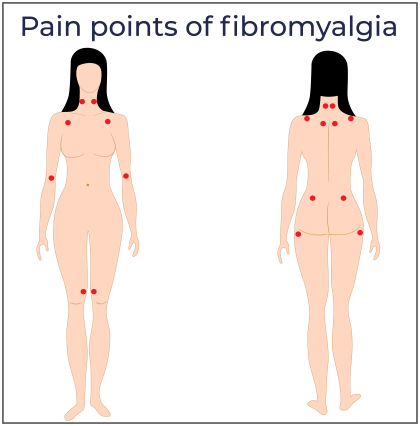
For a long time, the so-called “tender points” served as important indicators in making a diagnosis. These are a total of 18 paired points distributed over the body between the muscle insertion at the back of the head and the knee joints. All tender points are located at the transition from muscles to tendons. Fibromyalgia patients often have palpable indurations in these areas. To meet the diagnostic criterion, severe pain must be felt in at least 11 of these 18 points as soon as pressure is applied to them.
In 2010, the ACR changed its diagnostic criteria and continued to refine them in subsequent years. The basis is now the Widespread Pain Index (WPI) and the Symptom Severity Scale (SSS). The WPI asks about a total of 19 areas of the body where pain can occur. On the SSS, the severity of the three symptom domains “fatigue,” “non-restorative sleep,” and “cognitive symptoms” (e.g., ability to concentrate and remember, depression, anxiety) is mapped on a scale of 0 to 4. In addition, it is queried whether abdominal pain, depression, and headache are present. The resulting fibromyalgia scale ranges from 0 to 31. If a person reaches a score of 13 or more, he or she is most likely suffering from fibromyalgia.
Diagnoses of exclusion
The diagnostic criteria for fibromyalgia are very reminiscent of those for chronic fatigue syndrome (CFS). However, the low resilience as well as the prevailing state of exhaustion are in the foreground in this disease. Some researchers suggest that CFS and fibromyalgia may be two different manifestations of the same condition. Others assume similar causes leading to CFS or fibromyalgia depending on the individual constitution.
Due to the completely different manifestations of fibromyalgia syndrome, doctors often find it difficult to make the correct diagnosis. To make matters worse, there are few measurable parameters in fibromyalgia. Thus, it is primarily a diagnosis of exclusion. This means that various examinations do not reveal any causes for the patients’ complaints. For example, no abnormalities can be detected in the blood test as well as in MRI or CT. In the end, the only explanation left is fibromyalgia.
Diseases that should definitely be excluded in the course of diagnosis are
- CFS
- Muscular rheumatism (polymyalgia rheumatica)
- Rheumatoid arthritis,
- Myopathies,
- purely mental illnesses
What does "fibrous muscle pain" feel like?
Fibromyalgia is what experts like to call a “generalized, non-inflammatory pain syndrome.” The pain can occur in different places and with varying intensity. The neck, back and chest are usually particularly affected, as are the joints of the arms and legs. Patients themselves find it very difficult to localize the pain precisely. They describe its quality as “deep-seated,” “pungent,” “burning,” and “wandering,” among others. Outsiders can probably imagine this pain as being similar to sore muscles or aching limbs due to a fever. In some cases, sufferers also report nerve pain, tingling, burning and numbness.
Other typical symptoms in fibromyalgia
In the context of fibromyalgia, very different accompanying symptoms can occur. These must also be taken into account in the context of therapeutic measures. Fibromyalgia patients report the following disease-related complaints, among others:
- Tiredness / Fatigue
- Lack of drive
- rapid fatigue, reduced resilience
- delayed recovery after stress
- Sleep disorders
- Morning stiffness / general feeling of joint stiffness
- mental disorders such as depression or anxiety (30-50% of those affected)
- Weakness in memory and concentration, “brain fog
- Weather sensitivity
- Edema, feeling of swelling in the area of the hands, feet, or face.
- increased menstrual cramps
- Tinnitus and visual disturbances
- vegetative symptoms such as cold hands or feet
- increased sensitivity to noise, light, heat, cold and touch
- Dryness or hypersensitivity of the mucous membranes
- Food intolerances
- Irritable stomach and intestine
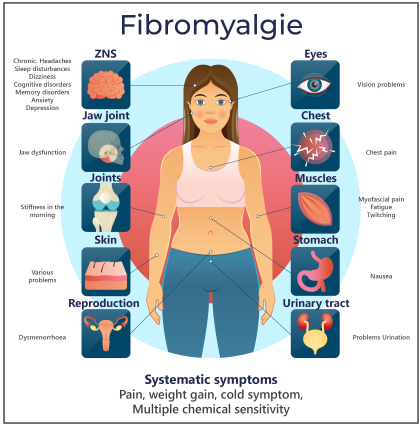
Regarding the last two points, fibromyalgia patients often have imbalances of the intestinal flora.
Why does fibromyalgia have so many different accompanying symptoms?
Why with a  Fibromyalgie syndrome so many vegetative complaints and hypersensitivities accompany, explain experts sometimes with an increased activity of the Sympathikus. This part of the nervous system jumps into action in stressful situations and sets the body up for flight or fight. Pain also means stress for us in this sense. Chronic pain therefore results in chronic stress and thus a permanent activation of the sympathetic nervous system. This is accompanied by a high sensitivity to environmental stimuli such as cold or noise.
Fibromyalgie syndrome so many vegetative complaints and hypersensitivities accompany, explain experts sometimes with an increased activity of the Sympathikus. This part of the nervous system jumps into action in stressful situations and sets the body up for flight or fight. Pain also means stress for us in this sense. Chronic pain therefore results in chronic stress and thus a permanent activation of the sympathetic nervous system. This is accompanied by a high sensitivity to environmental stimuli such as cold or noise.
Sometimes increased parasympathetic activity is also seen in fibromyalgia patients. Where exactly this stems from is unclear. But the two extremes of sympathetic and parasympathetic overactivity go some way to explaining why the accompanying symptoms are so different. Vital mushrooms such as Reishi and Hericium have been shown to have a positive effect on the nervous system and can thus provide relief.
EXPERIENCE REPORTS
"I have had both rheumatism and fibromyalgia for over 30 years. Now I have tried reishi, shiitake and hericium. The effect is good. My symptoms have improved significantly and the pain is relieved."
Favouring factors for fibromyalgia
So far, experts are not sure what conditions must be met for a person to have fibromyalgia. However, years of research and practice have shown that the following factors promote disease:
- genetic predisposition
- Certain infections are considered potential triggers
- an excess of negatively perceived psychological and / or physical stress
- certain character traits: strong sense of duty, great need to help others, frequent self-criticism, suppression of own emotions and needs
- Smoking, obesity and lack of exercise
- Mental or physical trauma (e.g. sexual abuse, accident)
In the actual onset of fibromyalgia, the following facts are also observed again and again:
- An increased stress load meets a reduced ability to adapt and regulate.
- Those affected suffer from an acquired malfunction of cellular energy production (mitochondrial dysfunction).
- On a physical level, there is a significant increase in oxidative stress.
- Fibromyalgia is closely linked to food intolerances.
- The endings of the finest nerves in the skin and muscles show changes. In addition, damage to the pain-conducting fibers can be seen in affected individuals.
Against the background of this complex factual situation, the difficulties of curing fibromyalgia naturally become very clear. But certain natural remedies such as vital mushrooms can provide relief in many ways.
Factor: Increased stress levels with reduced adaptive capacity.
 Regarding the reduced regulatory capacity, it can be said that this could be a genetically anchored problem. For example, there are people in whom the neurotransmitter serotonin is broken down more quickly than is the case on average in healthy people. This can contribute to an increased sensation of pain because nerve messengers (neurotransmitters) such as serotonin and dopamine or glutamate are significantly involved in stimulus or pain processing. In addition to serotonin deficiency, dysbalances with regard to other neurotransmitters are also frequently found in fibromyalgia patients. This could explain why sufferers experience even normal stimuli such as a touch as painful.
In addition, the body breaks down serotonin to melatonin. This hormone is in turn important for healthy sleep. If it is formed too much during the day, we feel limp and tired. At night it is then missing, so that we can only sleep poorly. Here, the medicinal mushrooms Reishi, Hericium and Cordyceps represent a suitable countermeasure, as they have a regulating effect with regard to stress hormones and nerve messengers. Thus, they improve stress resistance and sleep quality.
Regarding the factor “increased stress load”, it is interesting that many fibromyalgia patients report traumatic experiences in their childhood. They are therefore already burdened, sometimes downright traumatized. Up to 70% of those affected also report having suffered psychological or physical trauma at the onset of the actual disease. In both cases, the traumatic event equates to an extremely high stress level. Even in the course of the disease, correlations between stressful life situations and stronger symptom expression can be shown. Conversely, relaxed phases are usually accompanied by less pain.
Regarding the reduced regulatory capacity, it can be said that this could be a genetically anchored problem. For example, there are people in whom the neurotransmitter serotonin is broken down more quickly than is the case on average in healthy people. This can contribute to an increased sensation of pain because nerve messengers (neurotransmitters) such as serotonin and dopamine or glutamate are significantly involved in stimulus or pain processing. In addition to serotonin deficiency, dysbalances with regard to other neurotransmitters are also frequently found in fibromyalgia patients. This could explain why sufferers experience even normal stimuli such as a touch as painful.
In addition, the body breaks down serotonin to melatonin. This hormone is in turn important for healthy sleep. If it is formed too much during the day, we feel limp and tired. At night it is then missing, so that we can only sleep poorly. Here, the medicinal mushrooms Reishi, Hericium and Cordyceps represent a suitable countermeasure, as they have a regulating effect with regard to stress hormones and nerve messengers. Thus, they improve stress resistance and sleep quality.
Regarding the factor “increased stress load”, it is interesting that many fibromyalgia patients report traumatic experiences in their childhood. They are therefore already burdened, sometimes downright traumatized. Up to 70% of those affected also report having suffered psychological or physical trauma at the onset of the actual disease. In both cases, the traumatic event equates to an extremely high stress level. Even in the course of the disease, correlations between stressful life situations and stronger symptom expression can be shown. Conversely, relaxed phases are usually accompanied by less pain. On mytochondrial dysfunction.
It is not yet known exactly how a problem arises in the energy-producing processes at the cellular level. Hypotheses go in the direction that there could be a deficiency of certain substances that are needed in the synthesis of the energy unit ATP. Other conjectures assume a blockage of the enzyme chains in the mitochondria. Pollutants such as amalgam, pesticides or ingredients of medications could play a decisive role here. Last but not least, it is conceivable that the disturbance of energy production is to some extent genetically predisposed.
Let us now consider the consequences of a lack of energy units: If too little ATP is available, the body switches to lactic acid fermentation for energy production. As a result, the tissue becomes overacidified. This leads to hyperacidity (“acidosis”), which in the long term causes irritation of connective tissue structures. In addition, hyperacidity promotes inflammation, which in turn results in an increased occurrence of free radicals. This means: The oxidative stress load of the body increases.
Now, when the body releases inflammatory mediators, they irritate the nerve fibers, which can feel like pain to those affected. In fact, nearly half of all fibromyalgia patients have abnormalities in the “small fibers.” These are tiny nerve fibers that end in the skin and muscles. However, whether these changes are actually due to inflammatory processes and to what extent they are responsible for the excessive pain sensation has not yet been clarified.
On food intolerances and irritable bowel syndrome
 Fibromyalgia patients often exhibit imbalances of the intestinal flora. If the composition of the bacteria necessary for digestion is not correct, certain substances are not properly broken down in the intestine. They irritate the digestive tract, whereupon unpleasant symptoms such as abdominal pain, flatulence and diarrhea may occur. Experts refer to this as “irritable bowel syndrome”.
Fibromyalgia patients often exhibit imbalances of the intestinal flora. If the composition of the bacteria necessary for digestion is not correct, certain substances are not properly broken down in the intestine. They irritate the digestive tract, whereupon unpleasant symptoms such as abdominal pain, flatulence and diarrhea may occur. Experts refer to this as “irritable bowel syndrome”.
Dysbiosis can likewise lead to damage to the intestinal mucosa. As a result, this becomes more permeable, opening the door to allergens and other substances (leaky gut). The altered microbiome in the gut also decreases the production of serotonin, leading to the imbalances in the neurotransmitter system discussed earlier. Vital mushrooms have a positive influence on the intestine in many respects and are already successfully used for the treatment of irritable bowel syndrome and leaky gut. That is why they are also strongly recommended in fibromyalgia, which is associated with a dysbalance of the intestinal flora.
Other causes under discussion
In addition to the messenger substances  , the receptors of the nerve fibers are also suspected of promoting uninhibited stimulus transmission. Here, the focus is particularly on the opioid receptor system. If blockages occur here, even the smallest painful stimuli can be perceived as unbearable. Moreover, in this case, it would be understandable why opiate painkillers have only a limited effect.
, the receptors of the nerve fibers are also suspected of promoting uninhibited stimulus transmission. Here, the focus is particularly on the opioid receptor system. If blockages occur here, even the smallest painful stimuli can be perceived as unbearable. Moreover, in this case, it would be understandable why opiate painkillers have only a limited effect.
The situation regarding infections in the development of chronic pain syndrome is rather unclear. Physicians cannot definitively explain their role, but many sufferers name an infectious disease as the trigger of their illness.
Multimodal therapy approach
Because so little is known about the causes as well as the underlying physiological processes, it is almost impossible to cure fibromyalgia. Even conventional medicine has neither a patent remedy nor a standard therapy. The focus here is increasingly on a general recovery of quality of life. Individual measures are based on the specific symptoms and severity of the chronic pain. Ultimately, however, fibromyalgia is nowadays considered to be largely resistant to treatment.
The best changes in a positive direction are achieved by multimodal therapeutic approaches that simultaneously address different levels. This starts with a consciously healthy diet, extends to individually determined activity and exercise plans, and includes psychotherapeutic measures and relaxation exercises. All these approaches can be promoted and supported with specially tuned vital mushrooms. It is always important to keep an eye on the individual person with his or her symptoms, possibilities and also limitations.
Helpful vital mushrooms for fibromyalgia
Below we present the most important vital mushrooms for fibromyalgia. Through them, various symptoms can be relieved in sufferers such as pain, fatigue and hypersensitivity. In addition, they help to address the causes in therapy in the long term and to reduce stressful factors.
Reishi
With its various polysaccharides,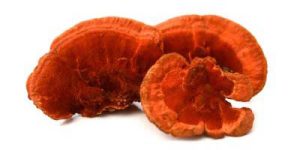 triterpenes and other valuable ingredients, Reishi is as richly stocked as a pharmacy cabinet. It provides relief from a wide variety of problems and can therefore also bring great relief to fibromyalgia patients. In the first place, it should be mentioned here that the Reishi has a mild analgesic effect. In addition, it has an overall calming as well as vegetative balancing effect. Thus, it can help to overcome the state of permanent overstimulation.
triterpenes and other valuable ingredients, Reishi is as richly stocked as a pharmacy cabinet. It provides relief from a wide variety of problems and can therefore also bring great relief to fibromyalgia patients. In the first place, it should be mentioned here that the Reishi has a mild analgesic effect. In addition, it has an overall calming as well as vegetative balancing effect. Thus, it can help to overcome the state of permanent overstimulation.
In addition, Reishi is a time-tested tonic that helps manage fatigue and lack of drive. At the organ level, for example, it activates the thyroid gland and supports it in its work. This prevents energy deficiency due to hypothyroidism and at the same time positively influences hormone balance. Overall, this medicinal mushroom has a regulating effect on the hormone balance and, in addition to the thyroid gland, reishi strengthens the liver in particular. This makes it one of the most important vital mushrooms when it comes to detoxification. We excrete fat-soluble pollutants via the liver and bile. Especially for the immune system this means a great relief. According to TCM, a weak liver is also closely related to depressive moods, which are more common in fibromyalgia patients.
Finally, the Reishi has also proven in the past to be …
- antioxidant,
- anti-inflammatory,
- prebiotic and
- anti-allergenic
proven.
Cordyceps
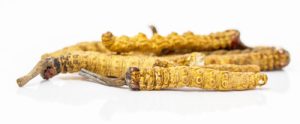 Cordyceps is also considered a vital mushroom that restores vital energy. Besides, it has proved its analgesic effect many times in the past. It also has ingredients that have a similar effect in the body as certain antidepressants called MAO inhibitors. Thus, it lifts the mood and is even able to relieve depressive symptoms.
Cordyceps is also considered a vital mushroom that restores vital energy. Besides, it has proved its analgesic effect many times in the past. It also has ingredients that have a similar effect in the body as certain antidepressants called MAO inhibitors. Thus, it lifts the mood and is even able to relieve depressive symptoms.
In terms of the elimination of harmful substances, Cordyceps is the ideal complement to Reishi. In fact, it promotes the kidneys in their work and thus stimulates the detoxification of water-soluble toxins. Especially in connection with latent acidosis, it is thus very important, because acid waste products are excreted in particular via the kidneys.
With regard to mitochondrial dysfunction, two positive properties of cordyceps should be highlighted at once. On the one hand, its ingredients improve ATP formation in the mitochondria themselves. On the other hand, the superoxide dismutase and glutathione contained in it have a strong antioxidant effect. This enables the body to render free radicals harmless, as they are increasingly formed during inflammation.
Even in terms of hormone balance, our experts can report a positive influence of the vital mushroom: For example, it stimulates the adrenal cortex, which is responsible for the production of the stress hormones cortisol and adrenaline, among other things. Overall, cordyceps brings more balance to the hormonal balance and can thus cushion a wide variety of imbalances and their symptoms.
Finally, it remains to mention the regulatory effect of cordyceps on blood sugar levels. It is so important because with fibromyalgia a rather uncontrolled fluctuating blood sugar level can be observed again and again, from which in the worst case diabetes can develop.
Hericium
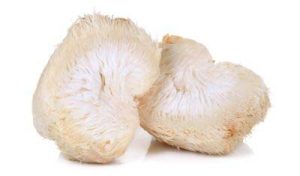 In the case of Hericium, two properties stand out that can be of great help in fibromyalgia. These are its positive effect on the nervous system on the one hand and its regenerating effects on the intestinal mucosa on the other. The erinacins from Hericium stimulate the so-called “nerve growth factor”, or “NGF” for short. This promotes myelin formation. Myelin sheaths surround our nerve fibers and are essential for their healthy functioning. Therefore, it is of great advantage, especially for people who are under constant stress, if the myelin sheaths are intact and regenerate again and again. This can even counteract a possible overstimulation. As a result, restlessness, sleep disorders, but also concentration problems decrease. The medicinal mushrooms Hericium and Reishi complement each other very well in terms of this calming effect.
In the case of Hericium, two properties stand out that can be of great help in fibromyalgia. These are its positive effect on the nervous system on the one hand and its regenerating effects on the intestinal mucosa on the other. The erinacins from Hericium stimulate the so-called “nerve growth factor”, or “NGF” for short. This promotes myelin formation. Myelin sheaths surround our nerve fibers and are essential for their healthy functioning. Therefore, it is of great advantage, especially for people who are under constant stress, if the myelin sheaths are intact and regenerate again and again. This can even counteract a possible overstimulation. As a result, restlessness, sleep disorders, but also concentration problems decrease. The medicinal mushrooms Hericium and Reishi complement each other very well in terms of this calming effect.
The fact that Hericium also stimulates the regeneration of the intestinal mucosa is a great advantage for people with food intolerances. It can rebuild the important mucosal barrier in the intestine and thus counteract intolerance reactions to food. Together with other vital mushrooms such as Reishi or Pleurotus, Hericium can eliminate imbalances with regard to the intestinal microbiome, so-called “dysbioses”. It also boosts the body’s production of serotonin. These are important factors that can help relieve IBS symptoms.
Pleurotus
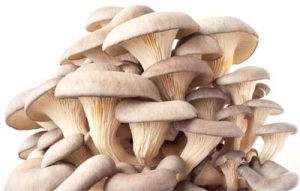 In the context of a powerful intestinal environment, Pleurotus is one of the most important vital mushrooms. With its ingredients, it promotes the regeneration of the intestinal flora when it is out of balance. In addition, the vital mushroom has a relaxing effect on our musculoskeletal system. It ensures that tense muscles, vision and ligaments loosen up again. This counteracts the very fiber-muscle pain from which fibromyalgia gets its name.
In the context of a powerful intestinal environment, Pleurotus is one of the most important vital mushrooms. With its ingredients, it promotes the regeneration of the intestinal flora when it is out of balance. In addition, the vital mushroom has a relaxing effect on our musculoskeletal system. It ensures that tense muscles, vision and ligaments loosen up again. This counteracts the very fiber-muscle pain from which fibromyalgia gets its name.
Polyporus & Poria cocos
The vital mushrooms Polyporus and Poria cocos help people who suffer from swelling due to edema as part of their fibromyalgia disease. Polyporus and Poria cocos now ensure that no or only minor edema forms. This is due to their dehydrating effect. Unlike dehydrating medications, however, they do not flush out potassium, which is why they are quite universal and can be used over a long period of time.
Polyporus also counteracts lymphatic congestion in particular. It keeps the lymph fluid, which is essential for the smooth detoxification of the body. In addition, the Poria cocos with its ingredients counteracts restlessness, nervousness and sleep disorders. For this reason, it is often recommended in very demanding, stressful periods of life.
Agaricus blazei murrill (ABM)
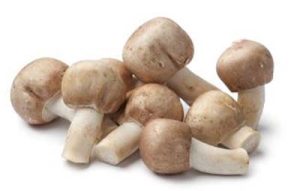 If the immune system weakens in connection with fibromyalgia, the medicinal mushroom ABM can provide relief. It is rich in beta-glucans, which support the immune system. If you are prone to infections, this may subside by taking the vital mushroom. In addition, ABM contains substances that have a direct antiviral and antibacterial effect.
If the immune system weakens in connection with fibromyalgia, the medicinal mushroom ABM can provide relief. It is rich in beta-glucans, which support the immune system. If you are prone to infections, this may subside by taking the vital mushroom. In addition, ABM contains substances that have a direct antiviral and antibacterial effect.
ABM is also good for fibromyalgia patients on a completely different level: it has a positive effect on serotonin production. This counteracts a deficiency of this important hormone, which in turn can reduce sensitivity to environmental stimuli.
Depending on the individual situation, concomitant diseases and already ongoing therapeutic measures, other medicinal mushrooms may also be useful, which we have not listed further here. We therefore recommend that you seek detailed advice from our experts in any case, in order to determine the ideal composition of vital mushrooms for you.
Other natural remedies for fibromyalgia
If you suffer from fibromyalgia, you should focus on an alkaline diet. This primarily counteracts latent acidosis and inflammatory processes. This relieves pain. The main component of your meals should be fruit and vegetables – both as natural as possible and little cooked. In this way, you supply your body with lots of enzymes, secondary plant substances and, above all, antioxidants. Nuts, flax and chia seeds are also highly recommended. Basically, it is important to drink at least two liters per day. Here, still water and unsweetened herbal teas are the first choice.
 In practice, heat-cold applications as well as massages have always proved helpful in curing at least some symptoms of fibromyalgia and its concomitant diseases. Sufferers also report improvements after undergoing detoxification. Vital mushrooms can also be a valuable support here, as they stimulate the various detoxification processes.
In practice, heat-cold applications as well as massages have always proved helpful in curing at least some symptoms of fibromyalgia and its concomitant diseases. Sufferers also report improvements after undergoing detoxification. Vital mushrooms can also be a valuable support here, as they stimulate the various detoxification processes.
Where can I buy vital mushrooms against fibromyalgia?
Before you get vital mushrooms to cure your fibromyalgia naturally, be sure to consult our experts. Indeed, it is only during the conversation that it becomes clear which medicinal mushrooms are right for your case. Blanket statements about which mushrooms in a certain dose can cure this or that disease are always unserious! It is always necessary to consider the overall physical condition. In particular, ongoing treatments and other diseases also play an important role.
Should you then look for a provider of vital mushrooms, please pay attention to the following criteria:
- The medicinal mushrooms are cultivated according to German organic standards.
- The whole mushroom is always processed.
- The medicinal mushrooms are gently dried at temperatures below 40° Celsius.
- The powder from the medicinal mushrooms is packaged in capsules.
The organic standards are so important because mushrooms sponge toxic substances from the soil, fertilizers or pesticides. When you eat it later, you then absorb all these harmful substances. Biological guidelines, on the other hand, ensure that the vital mushrooms do not come into contact with such substances in the first place.
The whole mushroom must always be processed gently, because only then it is guaranteed that all health-relevant ingredients are preserved. For example, some substances are more likely to be found in the fruiting body, others in the mycelium. Some enzymes break down at temperatures above 40° Celsius and can therefore no longer exert their effect in the body. Vital mushroom growers with high demands on their own quality know this and process their mushrooms accordingly.
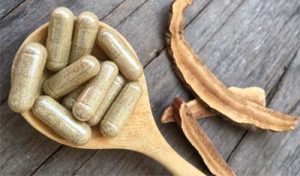 Finally, powder in capsules has proven to be the most favorable dosage form. The dry powder can be stored well as long as it is protected from moisture by a capsule shell. Open powder tends to grow mold. This is then very difficult to detect.
Finally, powder in capsules has proven to be the most favorable dosage form. The dry powder can be stored well as long as it is protected from moisture by a capsule shell. Open powder tends to grow mold. This is then very difficult to detect.
DO YOU HAVE ANY QUESTIONS?
We will gladly take time for you. In our free consultation we answer individually and personally all your health questions under:
